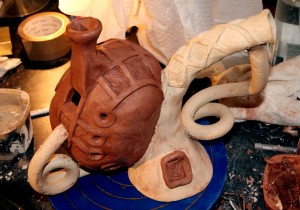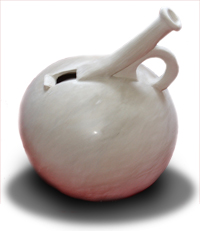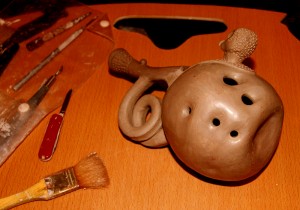 Of all the flutes, whistles, and ocarinas that I have posted on Flickr.com, the one that seems to show up in search engine results the most often is a simple pinch pot ball whistle from 2008. Entering the search string, Pinch Pot Whistle, into Google image search generally pulls that same image up within the top few results. There are several conclusions that one can draw from that, but I prefer to think that there are other people experimenting with hand-constructed whistles using nothing more than simple pinch pots.
Of all the flutes, whistles, and ocarinas that I have posted on Flickr.com, the one that seems to show up in search engine results the most often is a simple pinch pot ball whistle from 2008. Entering the search string, Pinch Pot Whistle, into Google image search generally pulls that same image up within the top few results. There are several conclusions that one can draw from that, but I prefer to think that there are other people experimenting with hand-constructed whistles using nothing more than simple pinch pots.
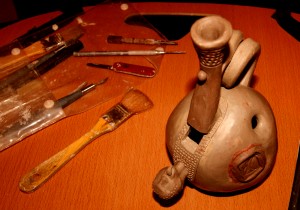 This particular piece employs the same basic construction, but raises the bar from whistle to a full octave ocarina. Two half sphere pinch-pots are joined by scoring the rims, adding a bit of slip, then carefully matching the edges so that a hollow ball results. At that point, the ball is allowed to rest in a sealed container so that the joint will mature and the ball reaches the leather hard stage. Meanwhile, the tubular mouthpiece, the pulled handle, and any surface decorations are built and allowed to rest prior to assembly.
This particular piece employs the same basic construction, but raises the bar from whistle to a full octave ocarina. Two half sphere pinch-pots are joined by scoring the rims, adding a bit of slip, then carefully matching the edges so that a hollow ball results. At that point, the ball is allowed to rest in a sealed container so that the joint will mature and the ball reaches the leather hard stage. Meanwhile, the tubular mouthpiece, the pulled handle, and any surface decorations are built and allowed to rest prior to assembly.
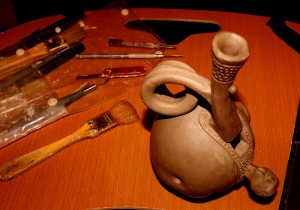 Perhaps the most critical step in constructing a tone-producing clay instrument is the carving of the tone hole and the assembly of the mouthpiece-tube so that the richest possible resonance occurs when air is blown through the tube. There are a few simple rules for the alignment, hole shape, and wedge positioning but I’ll not get into those details here…and certainly there are other methods of getting air into the instrument besides the manner illustrated here. Carving of finger holes is not an exact science but involves placement for ease of fingering (taking into consideration the shrinkage from drying and from firing) and understanding that proper hole size will adjust the pitch of each tone.
Perhaps the most critical step in constructing a tone-producing clay instrument is the carving of the tone hole and the assembly of the mouthpiece-tube so that the richest possible resonance occurs when air is blown through the tube. There are a few simple rules for the alignment, hole shape, and wedge positioning but I’ll not get into those details here…and certainly there are other methods of getting air into the instrument besides the manner illustrated here. Carving of finger holes is not an exact science but involves placement for ease of fingering (taking into consideration the shrinkage from drying and from firing) and understanding that proper hole size will adjust the pitch of each tone.
Dr. Bowen will have something to say about his discoveries that did not always turn out well for the person playing the instrument. For now, there are still questions of how similar were the techniques used over 1,000 years ago to the techniques that those searching Google for examples will find today. E.B. would say that it is part of the mystery of music and man’s attraction to making music his own.
